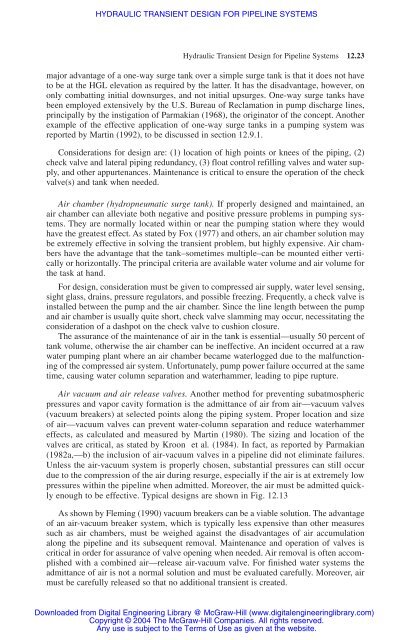chapter 12 hydraulic transient design for pipeline systems
chapter 12 hydraulic transient design for pipeline systems
chapter 12 hydraulic transient design for pipeline systems
Create successful ePaper yourself
Turn your PDF publications into a flip-book with our unique Google optimized e-Paper software.
HYDRAULIC TRANSIENT DESIGN FOR PIPELINE SYSTEMS<br />
Hydraulic Transient Design <strong>for</strong> Pipeline Systems <strong>12</strong>.23<br />
major advantage of a one-way surge tank over a simple surge tank is that it does not have<br />
to be at the HGL elevation as required by the latter. It has the disadvantage, however, on<br />
only combatting initial downsurges, and not initial upsurges. One-way surge tanks have<br />
been employed extensively by the U.S. Bureau of Reclamation in pump discharge lines,<br />
principally by the instigation of Parmakian (1968), the originator of the concept. Another<br />
example of the effective application of one-way surge tanks in a pumping system was<br />
reported by Martin (1992), to be discussed in section <strong>12</strong>.9.1.<br />
Considerations <strong>for</strong> <strong>design</strong> are: (1) location of high points or knees of the piping, (2)<br />
check valve and lateral piping redundancy, (3) float control refilling valves and water supply,<br />
and other appurtenances. Maintenance is critical to ensure the operation of the check<br />
valve(s) and tank when needed.<br />
Air chamber (hydropneumatic surge tank). If properly <strong>design</strong>ed and maintained, an<br />
air chamber can alleviate both negative and positive pressure problems in pumping <strong>systems</strong>.<br />
They are normally located within or near the pumping station where they would<br />
have the greatest effect. As stated by Fox (1977) and others, an air chamber solution may<br />
be extremely effective in solving the <strong>transient</strong> problem, but highly expensive. Air chambers<br />
have the advantage that the tank–sometimes multiple–can be mounted either vertically<br />
or horizontally. The principal criteria are available water volume and air volume <strong>for</strong><br />
the task at hand.<br />
For <strong>design</strong>, consideration must be given to compressed air supply, water level sensing,<br />
sight glass, drains, pressure regulators, and possible freezing. Frequently, a check valve is<br />
installed between the pump and the air chamber. Since the line length between the pump<br />
and air chamber is usually quite short, check valve slamming may occur, necessitating the<br />
consideration of a dashpot on the check valve to cushion closure.<br />
The assurance of the maintenance of air in the tank is essential—usually 50 percent of<br />
tank volume, otherwise the air chamber can be ineffective. An incident occurred at a raw<br />
water pumping plant where an air chamber became waterlogged due to the malfunctioning<br />
of the compressed air system. Un<strong>for</strong>tunately, pump power failure occurred at the same<br />
time, causing water column separation and waterhammer, leading to pipe rupture.<br />
Air vacuum and air release valves. Another method <strong>for</strong> preventing subatmospheric<br />
pressures and vapor cavity <strong>for</strong>mation is the admittance of air from air—vacuum valves<br />
(vacuum breakers) at selected points along the piping system. Proper location and size<br />
of air—vacuum valves can prevent water-column separation and reduce waterhammer<br />
effects, as calculated and measured by Martin (1980). The sizing and location of the<br />
valves are critical, as stated by Kroon et al. (1984). In fact, as reported by Parmakian<br />
(1982a,—b) the inclusion of air-vacuum valves in a <strong>pipeline</strong> did not eliminate failures.<br />
Unless the air-vacuum system is properly chosen, substantial pressures can still occur<br />
due to the compression of the air during resurge, especially if the air is at extremely low<br />
pressures within the <strong>pipeline</strong> when admitted. Moreover, the air must be admitted quickly<br />
enough to be effective. Typical <strong>design</strong>s are shown in Fig. <strong>12</strong>.13<br />
As shown by Fleming (1990) vacuum breakers can be a viable solution. The advantage<br />
of an air-vacuum breaker system, which is typically less expensive than other measures<br />
such as air chambers, must be weighed against the disadvantages of air accumulation<br />
along the <strong>pipeline</strong> and its subsequent removal. Maintenance and operation of valves is<br />
critical in order <strong>for</strong> assurance of valve opening when needed. Air removal is often accomplished<br />
with a combined air—release air-vacuum valve. For finished water <strong>systems</strong> the<br />
admittance of air is not a normal solution and must be evaluated carefully. Moreover, air<br />
must be carefully released so that no additional <strong>transient</strong> is created.<br />
Downloaded from Digital Engineering Library @ McGraw-Hill (www.digitalengineeringlibrary.com)<br />
Copyright © 2004 The McGraw-Hill Companies. All rights reserved.<br />
Any use is subject to the Terms of Use as given at the website.
















